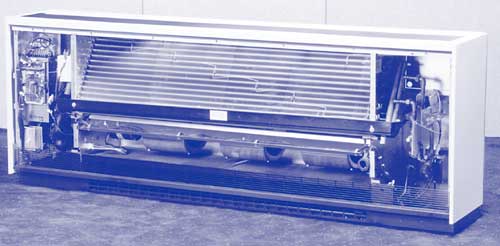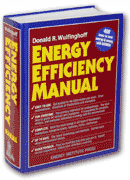Overview of…
5.3 Fan-Coil Units
This part of the Energy Efficiency Manual explains how to improve heating and cooling efficiency in fan-coil units. Fan-coil units provide heating, cooling, or both to individual spaces. They may be mounted in freestanding cabinets, inside walls, in ceiling plenums, or in other locations. Fan-coil units usually discharge air directly from their enclosures, although some may be installed with short ducts.
The main components of fan-coil units are a fan and one or two coils. Units may have separate heating and cooling coils, or a single water coil may be used for both functions. The coils may operate with hot water, chilled water, electric resistance, or rarely, steam. (Units with refrigerant coils are considered to be part of “split systems,” and they are covered in Subsection 5.5).
The output of a fan-coil unit can be controlled by cycling the fan, by controlling the speed of the fan, by throttling the flow of water in the coil, or by turning electric coils on and off. Units typically have control panels to allow occupants to select heating or cooling, to select the fan speed, and to control outside air ventilation, if any is available. Automatic controls may shut off flow through hydronic coils when the fan stops, and they may perform other functions. The fan-coil unit may have thermostatic controls that are entirely self-contained, or the fan-coil unit may have actuators that are powered by external thermostats.
Fan-coil units that are designed to provide a large amount of outside air ventilation are called “unit ventilators.” Unit ventilators are combined with relief air fans to provide positive control of outside air intake, maximize ventilation capacity, and direct the air flow. The unit ventilator and its relief fan should function as an integral system.
The energy conservation measures explained here include the maintenance needed to maintain efficiency, methods to avoid wasting the energy of the discharged air, high-efficiency fan motors, more efficient thermostatic controls, and major system conversions. The latter include conversion from a 3-pipe systems to a 2-pipe, and conversion of a 3-pipe system to a 4-pipe system.
Click here to return to the Table of Contents


